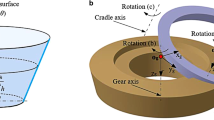Abstract
Based on the theories of digital conjugate surface and gear meshing, a generating method for digital gear tooth surfaces (DGTS) is demonstrated in this paper. The research focuses on the conjugate motion between the DGTS, represented by discrete points, and the cutter figuration determined by analytic function in the manufacture process. Conjugate points in the cutter section corresponding to the discrete points on the digital surface and conjugate movements are solved. Automated sequence arrangements of the generating movement parameters have been performed and the discrete generating movements are interpolated in a continuous conjugate motion along the order. Strategies of error analysis and error compensation are also discussed in this paper. Computer-simulated examples of the generating machining of involute DGTS and non-standard shaped DGTS, the parameters of machining motions and real tooth surfaces verify the developed method. The research develops a new idea for the machining of DGTS, which breaks the limitations of conventional approaches based on analytic surfaces. It is of important theoretical and practical value to manufacture digital surfaces. Our method is not only be applicable in generating machining of discrete DGTS and analytic gear tooth surfaces with complex geometric design, but also in contributing to the processing of discrete digital cam and other 3-D digital surfaces .
Similar content being viewed by others
References
Pfeifer T, Kurokawa S, Meyer S (2001) Derivation of parameters of global form deviations for 3-dimensional surfaces in actual manufacturing processes. Measurement 29:179–200
Amini N, Rosen BG, Westberg H (1998) Optimization of gear tooth surfaces. Int J Mach Tools Manuf 38(5–6):425–435
Chen L, Cooley DH, Zhang J (1999) The equivalence between two definitions of digital surfaces. Inf Sci 115:201–220
Su SH, Tseng CH (2000) Generating conjugate shapes using piecewise cubic spline function. Comput Methods Appl Mech Eng 187(2):245–260
Store J, Bulirsh R (1980) Introduction to numerical analysis, second edition. Springer, Berlin Heidelberg New York
Hees MV (1995) Towards practical knowledge-based design modeling. PRAD 2:1300–1412
Lee KY, Suh SW, Shin DW, et al. (1995) Development of a computerized ship design system. PRAD 2:1337–1349
Lin C, Tsay C, Fong Z (2001) Computer-aided manufacturing of spiral bevel and hypoid gears by applying optimization techniques. J Mater Process Technol 114:22–35
Wang SM, Ehmann KF (1992) Volumetric error compensation for multi-axis machines. In: Proceedings of the 1992 IEEE International Conference on Systems, Man and Cybernetics 1:183–188
Author information
Authors and Affiliations
Corresponding author
Rights and permissions
About this article
Cite this article
Wang, F., Yi, C., Wang, T. et al. A generating method for digital gear tooth surfaces. Int J Adv Manuf Technol 28, 474–485 (2006). https://doi.org/10.1007/s00170-004-2395-x
Received:
Accepted:
Published:
Issue Date:
DOI: https://doi.org/10.1007/s00170-004-2395-x




